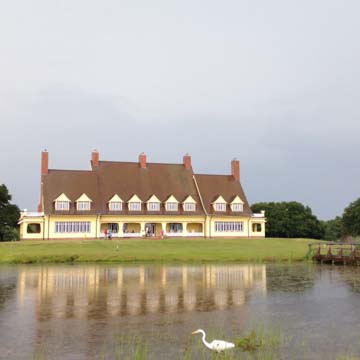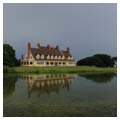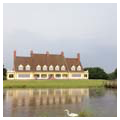You are here
Whalehead Club
The Whalehead Club is a rare survivor of North Carolina’s early-twentieth-century hunting lodges. The Club is located on the Outer Banks, a strand of barrier islands in the Atlantic Ocean, about a dozen miles south of the Virginia border in an area called Currituck Banks. In the 1920s, wealthy adventurists searched for a location rich in waterfowl and small game hunting—they found it here, building as many as ten shooting clubs in the area.
In 1922 railroad executive Edward C. Knight Jr. and his wife, Marie Louise Lebel, began building a private retreat on an isolated piece of property in Corolla. Both came from wealthy backgrounds and had lavish residences in Philadelphia and in Middletown, Rhode Island. Their design for the 21,000-square-foot lodge, which they called Corolla Island, exhibited stylistic characteristics of the Art Nouveau, Pennsylvania farmhouses, and the Arts and Crafts movement.
Set on a flat, marshy site, the house has a striking appearance formed primarily by dramatic, steeply sloped, copper-clad gable roofs that flare outward at the eaves. Nine distinctive gable dormers accentuate the roof along a symmetrical front and rear facades. The wood-clad exterior is painted a vibrant yellow. On the southern side of the lodge, facing Currituck Sound, a broad central porch is set behind a colonnade. On the northern or entry side, the mahogany doors are protected by a simple shed-roofed porch. Side porches are located off of each end of the lodge, providing panoramic views of the vast site.
The majority of the materials had to be shipped down the coast, many coming from Norfolk, Virginia. The massive house is constructed with structural steel beams to support the weight of the floors and roofs. The brick walls are three courses wide and up to eighteen inches thick in some areas, and the house has five brick chimneys. The main level included a large parlor with a fireplace, dining room, gun room, and boot room. Four guestrooms, each with its own bathroom, occupied the second floor. The house has two elevators and a swimming pool—the first examples of each in the northern Outer Banks—and the interiors are well ornamented with numerous Tiffany lighting fixtures.
In 1936, the Knights sold Corolla Island and returned to Rhode Island after Edward became ill. New owners (a consortium led by Ray T. Adams) renamed the house the Whalehead Club in 1939. The clubhouse served as a residence and bunker for the U.S. Coast Guard during World War II, and then as the Corolla School for Boys until 1962. During the Cold War the federal government leased the property as a rocket engine testing site. The club then fell into disrepair until the 1990s, when Currituck County bought the house and surrounding acreage, which included the nearby Currituck Lighthouse. Between 1999 and 2002 the county restored the hunting lodge.
Now open to the public for tours as part of the Historic Corolla Park, the Whalehead Club also serves as a wedding and special events venue.
References
Bishir, Catherine W. North Carolina Architecture. Portable edition. Chapel Hill: University of North Carolina Press, 2005.
Bishir, Catherine W., and Michael T. Southern. A Guide to the Historic Architecture of Eastern North Carolina. Chapel Hill: University of North Carolina Press, 1996.
Roberts, Claudia P., “The Whalehead Club,” Currituck County, North Carolina. National Register of Historic Places Inventory–Nomination Form, 1979. National Park Service, U.S. Department of the Interior, Washington, D.C.
Writing Credits
If SAH Archipedia has been useful to you, please consider supporting it.
SAH Archipedia tells the story of the United States through its buildings, landscapes, and cities. This freely available resource empowers the public with authoritative knowledge that deepens their understanding and appreciation of the built environment. But the Society of Architectural Historians, which created SAH Archipedia with University of Virginia Press, needs your support to maintain the high-caliber research, writing, photography, cartography, editing, design, and programming that make SAH Archipedia a trusted online resource available to all who value the history of place, heritage tourism, and learning.








